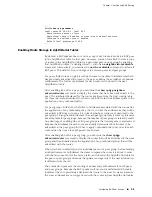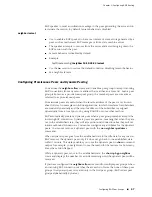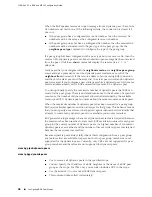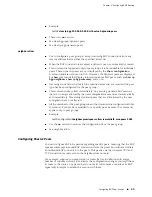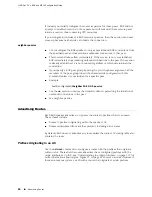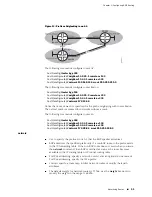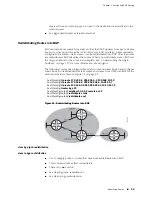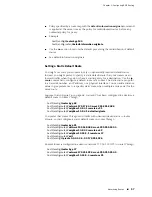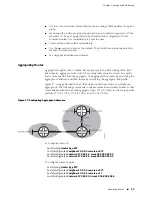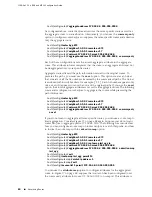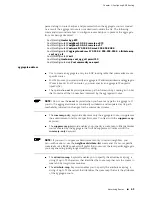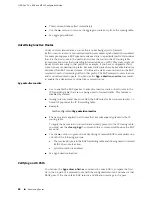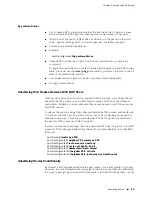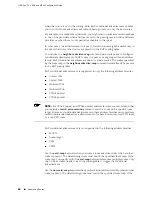
■
Example
host1#
clear ip bgp 192.168.1.158 vrf boston5 dynamic-peers
■
There is no
no
version.
■
See clear bgp ipv6 dynamic-peers.
■
See clear ip bgp dynamic-peers.
neighbor allow
■
Use to configure a peer group to accept incoming BGP connections from any
remote address that matches the specified access list.
■
When the BGP connection is accepted, a dynamic peer is automatically created.
■
This command is supported only for peer groups; it is not available for individual
peers. These dynamic peers are not displayed by the
show configuration
command and are not stored in NVS. However, the dynamic peers are displayed
by
show
commands that display information about BGP peers, such as
show ip
bgp neighbors
,
show ip bgp summary
, and so on.
■
Incoming connections that match the specified access list are rejected if no peer
type has been configured for the peer group.
■
This command takes effect immediately. Any existing dynamic BGP sessions
that are no longer allowed by the new configuration are removed automatically
and immediately. Preexisting dynamic peers that are still allowed by the new
configuration are not affected.
■
All the members of the peer group inherit the characteristic configured with this
command. It cannot be overridden for a specific peer, because the command
applies only to peer groups.
■
Example
host1(config-router)#
neighbor promispeers allow remotelist1 max-peers 1023
■
Use the
no
version to remove the configuration from the peer group.
■
See neighbor allow.
Configuring Passive Peers
You can configure BGP to be passive regarding specific peers, meaning that the BGP
speaker will accept inbound BGP connections from the peers but will never initiate
an outbound BGP connection to the peers. This passive status conserves CPU and
TCP connection resources when the neighbor does not exist.
For example, suppose you preprovision a router before installation with a large
number of customer circuits to minimize the configuration changes you might have
to make to the router. Any peers that do not exist will consume resources as BGP
repeatedly attempts to establish a session with them.
Configuring BGP Peer Groups
■
49
Chapter 1: Configuring BGP Routing
Summary of Contents for BGP
Page 6: ...vi ...
Page 8: ...viii JUNOSe 11 1 x BGP and MPLS Configuration Guide ...
Page 37: ...Part 1 Border Gateway Protocol Configuring BGP Routing on page 3 Border Gateway Protocol 1 ...
Page 38: ...2 Border Gateway Protocol JUNOSe 11 1 x BGP and MPLS Configuration Guide ...
Page 234: ...198 Monitoring BGP JUNOSe 11 1 x BGP and MPLS Configuration Guide ...
Page 236: ...200 Multiprotocol Layer Switching JUNOSe 11 1 x BGP and MPLS Configuration Guide ...
Page 542: ...506 Monitoring BGP MPLS VPNs JUNOSe 11 1 x BGP and MPLS Configuration Guide ...
Page 544: ...508 Layer 2 Services Over MPLS JUNOSe 11 1 x BGP and MPLS Configuration Guide ...
Page 610: ...574 Virtual Private LAN Service JUNOSe 11 1 x BGP and MPLS Configuration Guide ...
Page 624: ...588 VPLS References JUNOSe 11 1 x BGP and MPLS Configuration Guide ...
Page 680: ...644 Virtual Private Wire Service JUNOSe 11 1 x BGP and MPLS Configuration Guide ...
Page 724: ...688 Monitoring MPLS Forwarding Table for VPWS JUNOSe 11 1 x BGP and MPLS Configuration Guide ...
Page 725: ...Part 6 Index Index on page 691 Index 689 ...
Page 726: ...690 Index JUNOSe 11 1 x BGP and MPLS Configuration Guide ...







